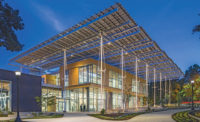For Denis Hayes, the journey to a leadership role in the environmental movement has been informed by childhood trauma, youthful disillusionment and an epiphany. The paper industry, which put food on his family's table, traumatized him by clear-cuting the landscape of his boyhood and belching toxins from its smokestacks. His disillusionment during the turbulent 1960s set off a three-year search for meaning in life that culminated in an epiphany during a trek through the Namibian desert: To help stem the planet's degradation, Hayes would devote himself to applying nature's principles of energy efficiency to civilization.

|
| HAYES |
Hayes likens Bullitt Center to a Douglas-fir forest. Even in gray-sky Seattle, the building, which is waste-independent, uses natural resources to provide fresh air, light, energy, heat and cooling for 150 occupants.
At six stories and 50,000 sq ft, Bullitt Center may be modest in size, but the building looms large as a global model for sustainable development.
"Denis is a tireless champion for significant, positive change, and the Bullitt Center is living proof that we can reinvent our cities based on ecological principles," says Jason McLennan, president and CEO of ILFI, which itself is a Bullitt Center tenant.
"This project not only raised the bar for [the building's architect] Miller Hull, it raised it for the design profession and the construction industry," adds Ron Rochon, a partner of the Miller Hull Partnership LLP.
PAE Consulting Engineers Inc., which also worked on the project, is proof of that. "While we were modeling the energy use, we suddenly realized that PAE could not meet the plug loads we were requiring for the Bullitt Center tenants," says Paul Schwer, president of PAE, which is also a tenant. "That fundamentally changed the computer systems we purchase for all our offices and reduced their energy use by over 75%."
Hayes is not always upbeat. "There are dark periods in the middle of the night," he says. But he keeps doing projects, thanks to "hope, determination and the willingness to work to exhaustion," he says.
W.W. Norton & Co. in March will release "COWED: The Hidden Impact of 93 Million Cows on America’s Health, Economy, Politics, Culture and Environment," a book by Hayes and his wife, Gail Boyer Hayes. Besides a new book on solar energy, Hayes also is planning a month-long celebration to mark the 50th anniversary, in April 2020, of Earth Day, observed by more than 140 nations since 1990.
Hayes counts Earth Day—the most widely celebrated secular holiday in the world—as his greatest achievement, saying, "It's a day when people plant trees, pick up litter and affirm commitments to values."



Post a comment to this article
Report Abusive Comment